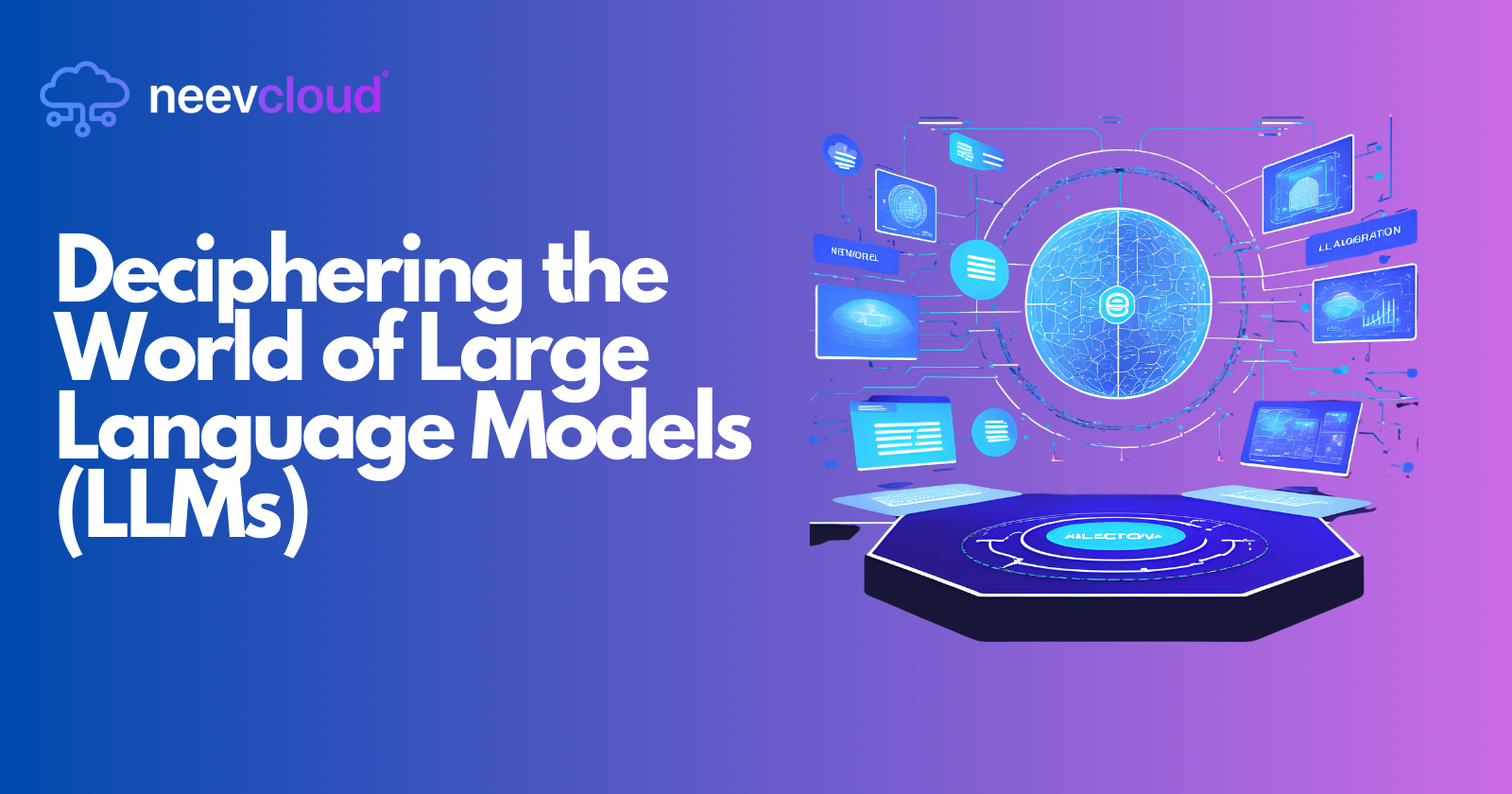Deciphering the World of Large Language Models (LLMs)
 Tanvi Ausare
Tanvi Ausare
In the age of artificial intelligence (AI), one of the most transformative advancements has been the development of Large Language Models (LLMs). These models are not just the backbone of modern conversational AI systems but also drive innovation in content creation, data analysis, and more. The rise of AI-powered cloud computing platforms, such as NeevCloud, has made it easier for developers and enterprises to harness the power of LLMs in a seamless, scalable way.
This blog post delves into the intricate world of LLMs, exploring their significance, architecture, applications, and the role of AI cloud and AI datacenters in fostering their development.
Table of Contents
What Are Large Language Models (LLMs)?
The Evolution of LLMs: From GPT to GPT-4
The Role of AI Cloud in LLM Development
AI Datacenters: The Infrastructure Powering LLMs
Key Applications of LLMs Across Industries
Challenges in Deploying and Scaling LLMs
Future Directions in the World of LLMs
Conclusion: How NeevCloud is Shaping the Future of AI
1. What Are Large Language Models (LLMs)?
Large Language Models (LLMs) are AI systems that have been trained on vast amounts of text data to understand, generate, and manipulate natural language. These models leverage deep learning and transformer architectures to generate coherent and contextually relevant sentences, paragraphs, or even documents. LLMs can perform tasks such as:
Text generation and completion
Sentiment analysis
Machine translation
Summarization
Code generation
At their core, LLMs like OpenAI’s GPT (Generative Pretrained Transformer) are designed to predict the next word in a sequence, which, with adequate training and scale, results in remarkably human-like responses.
Key Characteristics of LLMs:
Scale: LLMs are typically trained on billions, even trillions, of parameters.
Contextual Understanding: They can understand context across long passages of text.
Adaptability: LLMs can be fine-tuned for specific tasks or industries.
Pretraining and Fine-tuning: Pretrained on a broad dataset, LLMs can be specialized for more specific use cases through fine-tuning.
2. The Evolution of LLMs: From GPT to GPT-4
Key Milestones in LLM Development:
GPT-1 (2018): The first transformer-based model by OpenAI, trained with unsupervised learning on a massive dataset.
GPT-2 (2019): Marked a significant leap, capable of generating more coherent text, but was controversial due to potential misuse.
GPT-3 (2020): With 175 billion parameters, GPT-3 showcased unprecedented capabilities, from writing essays to coding.
GPT-4 (2023): GPT-4 has expanded the number of parameters and improved fine-tuning techniques, making it more reliable and versatile for complex tasks like nuanced conversations and long-form content creation.
Each new generation of LLMs refines the ability of AI to understand and generate human-like language, with improvements in accuracy, versatility, and scalability.
3. The Role of AI Cloud in LLM Development
The exponential growth in the size of LLMs brings with it massive computational demands. Here’s where AI Cloud platforms like NeevCloud become indispensable. AI clouds provide the infrastructure needed for building, training, and deploying LLMs at scale, without requiring businesses to invest in expensive hardware.
Benefits of Using AI Cloud for LLMs:
Scalability: LLMs require immense computational power for training and inference. AI cloud services allow users to scale resources up or down as needed.
Cost-efficiency: Businesses can avoid the high upfront costs of AI infrastructure by paying only for the cloud resources they consume.
Collaboration: AI clouds enable global teams to collaborate on LLM projects by providing a shared environment for development and deployment.
Security: Platforms like NeevCloud offer built-in security features, ensuring that sensitive data remains protected during training and inference phases.
Key Features of NeevCloud:
GPU Acceleration: NeevCloud leverages GPUs to handle the computational intensity of LLM training and inference, ensuring faster performance.
Auto-scaling: Automatically scales computational resources based on the model's requirements, optimizing cost and efficiency.
Pre-trained Models: NeevCloud offers pre-built models that businesses can fine-tune for specific tasks, reducing the time to deployment.
4. AI Datacenters: The Infrastructure Powering LLMs
Behind every sophisticated AI cloud is a powerful AI Datacenter. These datacenters are the physical backbone that provides the computing power needed to train, store, and deploy LLMs.
Key Components of AI Datacenters:
High-performance GPUs: Graphics Processing Units (GPUs) are essential for training LLMs. They enable the parallel processing needed to handle vast amounts of data.
Networking: Low-latency, high-bandwidth networks ensure that data can be quickly transferred across servers during the training process.
Cooling Systems: Due to the high computational demand of LLMs, AI datacenters need advanced cooling systems to prevent overheating.
Energy Efficiency: Modern AI datacenters focus on sustainable operations, optimizing for energy efficiency to minimize environmental impact.
Role of AI Datacenters in LLM Scaling:
Massive Parallelization: AI datacenters can parallelize the training process across thousands of GPUs, reducing the time required to train LLMs.
Distributed Computing: By distributing workloads across multiple servers, AI datacenters can manage the enormous datasets required for LLMs.
Data Management: Efficient storage and retrieval systems are crucial for handling the terabytes (or even petabytes) of data that LLMs consume.
5. Key Applications of LLMs Across Industries
The versatility of LLMs makes them applicable across a wide array of industries. Some prominent use cases include:
Healthcare: LLMs are being used for generating medical reports, summarizing patient data, and even assisting in drug discovery by analyzing scientific papers.
Finance: Financial institutions leverage LLMs for fraud detection, automated report generation, and algorithmic trading.
Education: AI-powered tutoring systems can provide personalized learning experiences by adapting to individual student needs.
Customer Support: Chatbots powered by LLMs are being deployed to handle customer queries, automate support tickets, and provide real-time assistance.
Legal: Legal professionals use LLMs to analyze case law, draft legal documents, and automate contract reviews.
Retail: AI-powered recommendation engines and inventory management.
Manufacturing: Predictive maintenance and real-time quality control.
Entertainment: Content creation, scriptwriting, and even digital avatars for interactive experiences.
6. Challenges in Deploying and Scaling LLMs
Despite the many benefits of LLMs, there are several challenges to their deployment and scaling:
High Computational Costs: Training LLMs can be prohibitively expensive due to the need for vast amounts of computing power.
Latency in Inference: Large models may suffer from high latency during real-time inference, which can hinder applications requiring instantaneous responses.
Data Privacy: Training LLMs on sensitive data can pose privacy risks, requiring strict security protocols to safeguard user information.
Bias in Training Data: LLMs are only as good as the data they are trained on. If biased data is used, the models may produce biased or problematic outputs.
7. Future Directions in the World of LLMs
As the field of AI continues to evolve, we can expect several trends and advancements in LLMs:
Smaller, More Efficient Models: Researchers are exploring ways to make LLMs smaller and more efficient without sacrificing performance.
Multimodal LLMs: Future LLMs will likely integrate not only text but also images, video, and audio, leading to more comprehensive AI systems.
Federated Learning: Privacy-preserving techniques such as federated learning may allow for the training of LLMs on decentralized data without compromising user privacy.
Real-time Adaptation: LLMs may become more adaptable, adjusting their behavior in real time based on user input and feedback.
8. Conclusion: How NeevCloud is Shaping the Future of AI
In the world of Large Language Models, NeevCloud is at the forefront, providing the tools and infrastructure necessary for organizations to harness the power of AI. By offering cutting-edge AI cloud services, NeevCloud simplifies the deployment, scaling, and fine-tuning of LLMs, empowering businesses to innovate faster and at a lower cost.
As LLMs continue to transform industries, NeevCloud’s commitment to leveraging AI datacenters and GPU-accelerated platforms will play a critical role in driving the next wave of AI innovation. Whether you are a small startup or a large enterprise, NeevCloud can help you tap into the immense potential of LLMs, driving value and delivering impactful AI-driven solutions.
By embracing the future of LLMs and AI cloud platforms like NeevCloud, businesses can stay ahead of the curve, turning AI from a buzz.
Subscribe to my newsletter
Read articles from Tanvi Ausare directly inside your inbox. Subscribe to the newsletter, and don't miss out.
Written by
